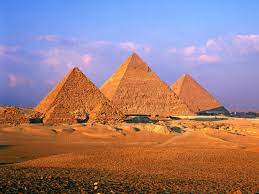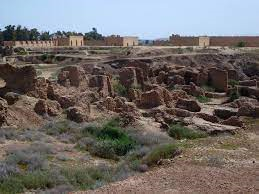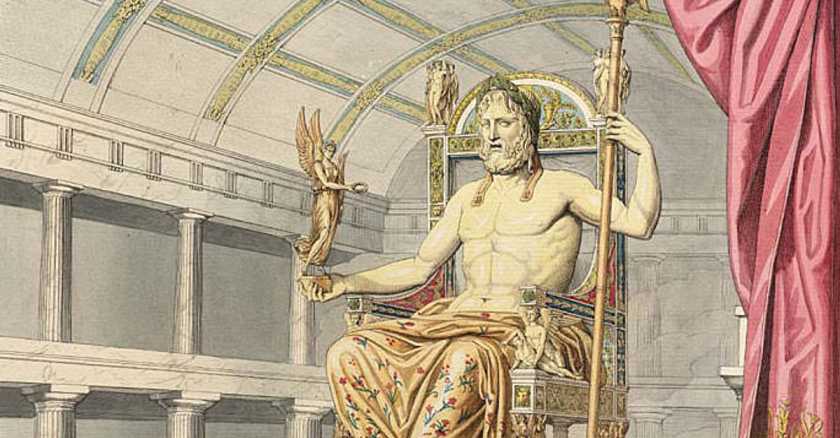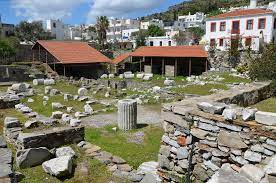The 5 Old Wonders Of The World
1.1 ) Great Pyramid of Giza (Egypt):

location of pyramid of giza: 29.9792° N, 31.1342° E
- The only remaining wonder of the ancient world, built as a tomb for Pharaoh Khufu.
The Great Pyramid of Giza in Egypt stands as the sole surviving wonder of the ancient world, serving as the monumental tomb for Pharaoh Khufu. Situated near Cairo, this iconic structure embodies the epitome of ancient civilization. Here, we outline five essential aspects of the Great Pyramid:
- Construction and Purpose:
- Time of Construction: Erected during the Fourth Dynasty of the Old Kingdom of Ancient Egypt, circa 2580–2560 BCE.
- Architect: Traditionally credited to Pharaoh Khufu, also known as Cheops, it was part of a complex that included smaller pyramids for Khufu’s queens.
- Architectural Features:
- Size: Originally towering at approximately 146.6 meters (481 feet), the Great Pyramid reigned as the world’s tallest man-made structure for over 3,800 years.
- Construction Material: Comprising predominantly limestone and granite, the pyramid consists of around 2.3 million stone blocks, each weighing several tons.
- Precision: The construction showcases remarkable precision in stone placement, with the pyramid’s sides aligning precisely with the cardinal points of the compass.
- Function and Significance:
- Funerary Purpose: Serving as the final resting place for Pharaoh Khufu, the internal chambers contain burial chambers and associated structures.
- Symbolism: Designed to symbolize the ascent of the pharaoh’s soul to the afterlife, reflecting ancient Egyptian beliefs in an afterlife.
- Construction Techniques:
- Labor Force: The construction engaged a substantial labor force, likely comprising skilled workers, laborers, and slaves.
- Transportation of Stones: The transportation and positioning of colossal stones remain speculative, with theories ranging from sledges to counterweighted systems.
- Legacy and Preservation:
- Survival: As the only remaining wonder of the ancient world, the Great Pyramid endures.
- Tourism and Study: A significant tourist attraction, ongoing archaeological and scientific research employs advanced technology to unveil further details about its construction and purpose.
The Great Pyramid of Giza continues to capture global fascination, standing as a testament to the ingenuity and advanced engineering skills of ancient Egyptian civilization. Its grandeur, enigmatic design, and enduring mysteries make it an enduring symbol of the ancient world.
1.2 ) Hanging Gardens of Babylon (Iraq):

Ancient terraced gardens, often considered one of the greatest feats of engineering.
The Hanging Gardens of Babylon, though often described as one of the Seven Wonders of the Ancient World, remain a subject of historical debate and mystery. Here are five key points about the Hanging Gardens:
- Existence and Location:
- Controversy: The existence of the Hanging Gardens is not definitively confirmed, and their location is a matter of historical uncertainty.
- Babylon: Traditionally, they are associated with the ancient city of Babylon in present-day Iraq, during the reign of King Nebuchadnezzar II (c. 605–562 BCE).
- Construction and Design:
- Feats of Engineering: The Hanging Gardens are described as a series of terraced gardens constructed on elevated platforms, possibly with a complex system of irrigation to support plant life.
- Purpose: According to historical accounts, the gardens were created to please Queen Amytis of Media, who missed the green hills and valleys of her homeland.
- Architectural Marvel:
- Artistic Descriptions: Ancient accounts, including those by the Greek historians Strabo and Philo of Byzantium, describe the Hanging Gardens as an engineering marvel with trees, shrubs, and plants arranged in a tiered fashion.
- Aqueducts or Archimedes Screw: Theories about the irrigation system include the use of aqueducts or an Archimedes screw to lift water to the elevated gardens.
- Historical Accounts:
- Primary Sources: The primary historical accounts of the Hanging Gardens come from ancient Greek writers such as Strabo and Philo of Byzantium, who lived several centuries after the reported existence of the gardens.
- Nebuchadnezzar II: The Hanging Gardens are commonly associated with Nebuchadnezzar II, a powerful Babylonian king, though contemporary Babylonian texts do not explicitly mention them.
- Debates and Challenges:
- Historical Skepticism: Some historians and archaeologists have questioned the existence of the Hanging Gardens as described in classical accounts, suggesting that they may be a product of legend or exaggeration.
- Alternate Locations: Some theories propose that the gardens could have been located in Nineveh, the capital of the Assyrian Empire, rather than Babylon.
The Hanging Gardens of Babylon remain a captivating historical enigma, and while there is no conclusive archaeological evidence supporting their existence in Babylon, the concept of these lush, elevated gardens has persisted in historical narratives and popular imagination.
1.3 ) Statue of Zeus at Olympia (Greece):

Location of Statue of Zeus at Olympia (Greece): 37° 38′ 9.77″ N 21° 37′ 28.79″ E
A colossal statue of the Greek god Zeus, created by the sculptor Phidias.
The Statue of Zeus at Olympia was an ancient marvel, and here are five key points about this colossal statue:
- Creation and Sculptor:
- Sculptor Phidias: The renowned ancient Greek sculptor Phidias, who also worked on the Parthenon sculptures in Athens, is credited with creating the Statue of Zeus.
- Time of Creation: The statue was completed around 435 BCE, during the Classical period of ancient Greece.
- Location:
- Olympia: The statue was erected in the Temple of Zeus at Olympia, situated in the sanctuary of Olympia in Greece. Olympia was a significant religious and athletic center, hosting the ancient Olympic Games.
- Physical Description:
- Colossal Size: The Statue of Zeus was approximately 13 meters (43 feet) tall, making it one of the tallest statues of the ancient world.
- Material: The statue was crafted from a wooden core covered in ivory plates and gold leaf, showcasing the artistic and luxurious tastes of the time.
- Depiction of Zeus:
- Representation: Zeus, the king of the Greek gods, was depicted seated on a throne, holding a scepter in one hand and a small statue of Nike (the goddess of victory) in the other.
- Gold and Ivory: The use of gold and ivory not only contributed to the grandeur of the statue but also symbolized the divine nature of Zeus.
- Cultural Significance:
- Religious Context: The Statue of Zeus was a central feature of the Temple of Zeus at Olympia, a major religious site in ancient Greece dedicated to the worship of Zeus.
- Olympic Games: The statue became an integral part of the religious ceremonies and festivities held during the ancient Olympic Games, emphasizing the connection between athletic prowess and divine favor.
Unfortunately, the Statue of Zeus at Olympia no longer exists. It was likely destroyed or damaged over time, and its exact fate remains unknown. Despite its absence, the statue’s legacy lives on through historical accounts, descriptions by ancient writers, and artistic representations that provide insights into the grandeur of ancient Greek art and religious practices.
1.4 ) Temple of Artemis at Ephesus (Turkey):

A grand temple dedicated to the goddess Artemis, known for its beauty and size.
The Temple of Artemis at Ephesus was an ancient wonder, and here are five key points about this grand structure:
- Location and Setting:
- Ephesus: The Temple of Artemis was located in the ancient city of Ephesus, near the modern-day town of Selçuk in Turkey.
- Sacred Grove: The temple was situated within a sacred grove dedicated to Artemis, the Greek goddess of the hunt, wilderness, and fertility.
- Architectural Features:
- Magnificent Size: The Temple of Artemis was one of the largest temples of the ancient world. It was reported to be approximately 115 meters (377 feet) long and 55 meters (180 feet) wide.
- Columns and Decoration: The temple was adorned with a plethora of Ionic columns and featured intricate friezes and sculptures. It was a prime example of ancient Greek Ionic architecture.
- Cultural and Religious Significance:
- Dedication to Artemis: The temple was dedicated to Artemis, a revered goddess in Greek mythology. Artemis was associated with hunting, nature, and the protection of women and young girls.
- Pilgrimage Site: The sanctuary at Ephesus, with the Temple of Artemis at its heart, attracted pilgrims and worshippers from various parts of the ancient world.
- Construction and Reconstructions:
- Initial Construction: The original temple on the site was built around 550 BCE, but it was destroyed by a flood in 356 BCE.
- Alexander the Great’s Rebuilding: Alexander the Great contributed to the financing of the reconstruction, overseen by the architect Dinocrates, who expanded and enhanced the temple.
- Destruction and Legacy:
- Arson Incident: The Temple of Artemis gained historical notoriety when it was destroyed by arson in 356 BCE by a man named Herostratus, who sought fame.
- Reconstruction Attempts: Despite its destruction, the temple was rebuilt multiple times by different rulers, including Alexander the Great and the Romans. However, it was eventually abandoned and fell into ruin over the centuries.
- Legacy: The Temple of Artemis, despite its physical absence today, is remembered as one of the Seven Wonders of the Ancient World, and its architectural and cultural significance has left a lasting impact on the history of ancient Greek civilization.
While the physical remains of the Temple of Artemis are limited, archaeological excavations at the site have uncovered some remnants, and reconstructions and artistic depictions provide insights into the grandeur of this ancient marvel.
1.5 ) Mausoleum at Halicarnassus (Turkey):

Location of Mausoleum at Halicarnassus (Turkey) : 37.0379° N, 27.4241° E
The tomb of Mausolus, the Persian satrap of Caria, renowned for its architecture and art.
The Mausoleum at Halicarnassus was a remarkable ancient structure, and here are five key points about this historical tomb:
- Location and Builder:
- Halicarnassus: The Mausoleum was located in the city of Halicarnassus, which is present-day Bodrum in Turkey.
- Mausolus: The tomb was commissioned by Artemisia II, the wife and sister of Mausolus, the Persian satrap (governor) of Caria. It was built in memory of Mausolus after his death in 353 BCE.
- Architectural and Artistic Features:
- Blend of Styles: The Mausoleum was designed by the Greek architects Satyros and Pythius. It blended various architectural styles, including Greek, Egyptian, and Lycian influences.
- Sculptural Decorations: The exterior of the Mausoleum was adorned with intricate friezes, statues, and sculptures, showcasing the talents of renowned artists of the time, including Bryaxis, Scopas, Timotheus, and Leochares.
- Size and Structure:
- Monumental Scale: The Mausoleum was a monumental structure, featuring a square base with a peristyle of columns and a series of stepped layers, leading to a central tomb chamber.
- Statue of Mausolus: At the pinnacle of the Mausoleum, there was a colossal statue of Mausolus and a chariot, adding to the overall grandeur.
- Cultural Significance:
- Origin of the Term “Mausoleum”: The Mausoleum at Halicarnassus is the origin of the term “mausoleum,” which is now commonly used to describe large tombs or burial structures.
- Symbol of Architectural Achievement: The Mausoleum was considered one of the Seven Wonders of the Ancient World and stood as a symbol of the architectural and artistic achievements of the time.
- Destruction and Excavation:
- Earthquakes and Decline: The Mausoleum suffered damage from earthquakes over the centuries, and it eventually fell into ruin.
- Rediscovery: The remnants of the Mausoleum were rediscovered by British archaeologists in the mid-19th century. Excavations revealed fragments of the sculptures and the foundations of the structure.
While the Mausoleum at Halicarnassus is no longer standing in its original grandeur, artifacts and sculptures from the site, including the famous Mausoleum friezes, are housed in the British Museum in London and the Bodrum Museum of Underwater Archaeology in Turkey. These remnants provide valuable insights into the artistic and architectural achievements of ancient Caria.
people also read :
Exploring the Heights: Top 5 Trekking Adventures in Maharashtra
A Journey Through The Top 5 Must-Visit Tourist Destinations In maharashtra


